The financial sector is undergoing a major transformation driven by artificial intelligence (AI). From detecting fraud in real-time to predicting market risks with greater accuracy, AI has become a crucial tool for risk managers. As financial institutions face increasing volatility, regulatory scrutiny, and data complexity, AI is stepping in to offer smarter, faster, and more secure ways to manage risk.
A Brief History of AI in Finance
AI’s integration into finance began with basic algorithmic trading models and rule-based fraud detection systems in the early 2000s. However, the real shift came with advancements in machine learning and big data analytics. These technologies enabled AI to learn from vast datasets, detect subtle patterns, and evolve continuously.
Key Applications of AI in Financial Risk Management
1. Fraud Detection
AI systems can identify unusual transaction patterns that signal fraud, even in real-time. Using machine learning models trained on historical fraud data, financial institutions can flag suspicious activities faster than traditional rule-based systems. Source: World Economic Forum on AI and Finance
2. Credit Risk Assessment
Traditional credit scoring often misses nuanced borrower behaviors. AI can analyze alternative data sources—such as transaction histories, social media, and utility payments—to assess creditworthiness more accurately, expanding financial inclusion.
3. Market Risk Prediction
AI-powered models simulate thousands of market scenarios to predict potential losses. This is especially useful for stress testing and forecasting in volatile environments. Source: McKinsey on AI Risk Modeling
4. Regulatory Compliance
RegTech, powered by AI, automates compliance monitoring and reporting. AI scans large volumes of transactions and documentation to ensure adherence to regulations like Basel III or the EU’s GDPR.
Benefits of AI-Driven Risk Management
- Speed and Accuracy: AI reduces human error and delivers faster analysis.
- Scalability: AI can handle massive datasets without performance issues.
- Proactive Risk Mitigation: Instead of reacting to problems, organizations can prevent them.
Challenges and Ethical Considerations
Despite its benefits, AI adoption in financial risk management faces challenges:
- Bias in Algorithms: Poor training data can result in biased decisions.
- Transparency: AI’s decision-making process can be a black box.
- Regulatory Uncertainty: Rapid AI evolution often outpaces legal frameworks.
What’s Next for AI in Risk Management?
We can expect:
- Explainable AI (XAI): Improving transparency and trust.
- AI + Human Collaboration: Enhancing judgment with intelligent insights.
- Edge AI in Finance: Enabling faster risk decisions at the data source.
Internal Links:
- How AI-Driven Analytics is Reshaping Business Decision-Making in 2025
- Data Governance in the AI Era: Ensuring Security and Compliance


Recent Comments